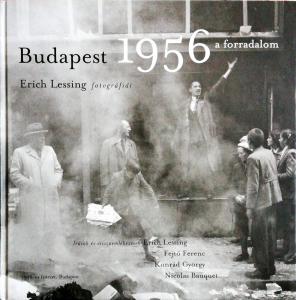
Budapest 1956 – The Revolution
Budapest 1956 - a forradalom. Erich Lessing fotográfiái
(Budapest 1956 – The Revolution. Photographs by Erich Lessing)
Budapest, Institute of 1956, 2006, 249 pages
ISBN 963 866 355 3
In the autumn of 1956, Budapest was on the world's radar. The Hungarian Revolution, the Hungarian people's uprising against the Soviet-style regime, was a source of surprise and hope around the world. Hope that the revolution of human dignity had a chance against the might of a giant oppressive power. The uprising failed, but its moral example is still being remembered.
Photojournalist Erich Lessing, member of the Magnum International Photo Agency in Paris, visited Hungary three times in 1956. As an expert on the situation in Eastern European countries, he showed with particular sensitivity the depressing reality of life in the regions under Soviet control. In the period before the revolution, in May and June, he spent extended periods in Budapest and on rural reporting trips, visiting factories and farmers' cooperatives, among other places. His footage thus forms a rounded, complete story of that year. His pictures show Hungary before the revolution, only seemingly peaceful, Hungarian society at the moment of what was thought to be victory, and then the city and its inhabitants preparing to survive after defeat. The highlights of the autumn of 1956, but also its shadows. In the days of the revolution, he was present on the Corvin Passage, on the Great Boulevard, and took dramatic pictures of the events in Republic Square. Lessing's tabloid of the autumn of 1956 in Budapest is a unique visible story that draws a complete picture.
Erich Lessing's name is – by now – associated with the 1956 Hungarian Revolution and War of Independence. During the days of the revolution, many photographs were taken and circulated in the world press, including more than a dozen foreign photojournalists covering the events of 1956, but perhaps none of them succeeded in taking pictures that understood the situation, social movements and changes in the countries behind the Iron Curtain, and saw the events from the inside, as he did.
In this monumental volume, published by the Institute of 1956, the photos are complemented by a few reminiscences, including the memories of 1956 of photographer Nicolas Bauquet, Ferenc Fejtő and György Konrád.
Shopping
Our publications are available in our bookshop, or can be ordered from the Publications Department of the NSZL using the contact details below: Főigazgatói Kabinet kiadványtára, Országos Széchényi Könyvtár, 1276 Budapest P.O. box 1205., phone: 06-1-23-23-506, e-mail: kiadvanytar@oszk.hu.




